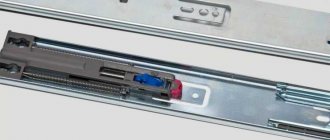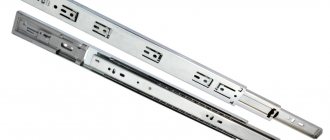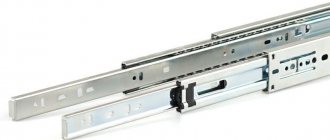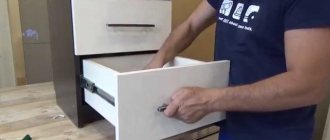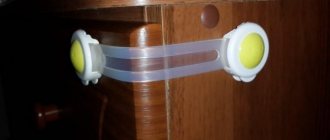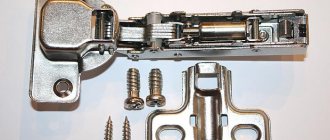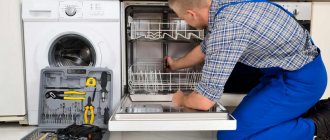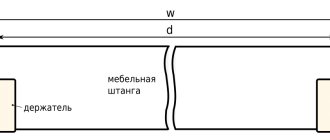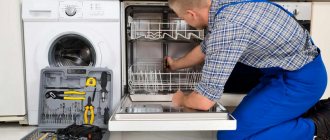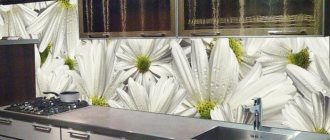Today, most furniture items placed in the living room, children's room, kitchen and bathroom have retractable elements, which are structurally represented by drawers, tabletop extensions, trays and transformable additions. Currently, when installing them, various categories of guides are used, which significantly increase the ergonomics and ease of use of furniture.
Despite the fairly widespread use of sled guides in the form of plastic or wooden blocks, roller and ball guides are becoming increasingly common today.
Despite the simplicity of design, low cost and ease of installation of roller systems, ball devices are considered a worthy alternative. Despite the high price and laid structure, this type of fittings has the following advantages:
- greater smoothness and quiet operation;
- more uniform load distribution across individual rolling elements (balls);
- higher stability, which minimizes drawer distortion;
- greater reliability - even if several balls are defective, the load will be evenly redistributed to the rest.
Design features
To properly install such runners on furniture, you first need to understand what the structure consists of.
There are 2 main types of ball guides:
- double row;
- four-row.
Their design is identical. Yes, and installation is carried out the same way. But in terms of operation, two-row ones differ from four-row ones. The first type is more affordable and can withstand a load of no more than 35 kilograms.
Ball type guide design
If you are counting on a long service life, as well as a large loading capacity of the boxes, it is recommended to choose 4-row products.
Structurally, the ball type guides consist of 2 metal profiles that contact each other using ball rolling elements. The balls themselves are usually made of steel. But there are also options made of nylon. They are distributed in the recesses of the cradle as evenly as possible.
The length of the profile, as well as design features, allow the drawer to be completely pulled out from the cabinet and chest of drawers. To ensure that the box does not go beyond the permissible limits, the runners are often additionally equipped with clamps (stops) or closers. This is especially convenient if the fittings will be attached to a computer desk.
What's inside the ball guides
How to choose?
When choosing furniture guides, you need to pay attention to various factors. It is thanks to them that it is possible to smoothly and silently open and close different drawers, which can be installed in cabinets, chests of drawers, dressing tables, hallways and other types of cabinet furniture.
When choosing products, various factors and recommendations are taken into account:
- The dimensions of the guides must ideally match the furniture where the drawer will be installed, as well as this element itself, otherwise installation will be complicated;
- In the store, before purchasing, you should make sure that the metal has the optimal thickness, and that all rollers or balls are working properly;
- Externally there should not be any scratches, visible defects or violations of the integrity of the structure;
- A specific type of guide is selected, since some users prefer roller products, while others prefer ball models;
- If guides are selected to replace outdated or broken elements, then similar models are usually purchased;
- Immediately after purchase, you need to make sure that the kit includes all the necessary parts for installation;
- If you choose modern tandem boxes, you should make sure that you can handle the installation yourself. Such products are considered quite specific, so installation often requires the help of specialists;
- The minimum metal thickness should be 1 mm, but it is better to choose designs where this figure will not be less than 1.2 mm. This will allow you to easily cope with high loads and ensure long-term operation.
Thus, furniture guides are important parts of various interior items. These are fittings that make drawers easy to use. Guides are presented in several types, each of which works according to a specific principle. When choosing a specific design, various factors are taken into account to ensure that you can purchase truly high-quality elements.
Advantages and disadvantages
Many people decide to use ball guides because they have a wide range of objective advantages. Namely:
- wide extension range;
- large selection of accessories;
- the presence of closers and stops that increase work safety;
- full extension, which gives access to the entire depth of the drawer;
- Possibility of use on different types of furniture;
- the use of high quality metal and components (especially from manufacturers such as Boyard);
- easy and silent sliding;
- no need to mill grooves for installation;
- relatively small size with a solid load capacity;
- collapsible design;
- possibility of installation by yourself.
Full extension ball slides
One of the main competitors is the concealed slides.
As for the shortcomings, everything is relative.
If you take high quality products, as well as from a reliable manufacturer, then the only disadvantage in this situation can be considered only a higher cost. This is compared to roller skids that are noisy, short-lived, and lack the ability to fully extend.
If the ball guides turn out to be of poor quality, then you should expect not the most reliable operation and rapid failure.
What you definitely shouldn’t do is choose roller guides for drawers when it is possible to install ball runners.
Ball type guides
Features of application
In addition to ordinary household furniture products, ball guides have found the widest application in furniture for specific purposes. For example, the tight space of a bathroom does not allow the use of cabinets with standard-length drawers, so fittings that make it possible to fully pull out shallow drawers are suitable here. Due to the noiseless operation, full extension systems are equipped with cabinets in medical institutions, drawer racks for archives, and recording studios, where maintaining silence is one of the working conditions. To make their operation quieter, some manufacturers additionally enclose metal balls in plastic separators.
On a note!
Special guides with a square cross-section often have the option of hidden installation (in a groove), making the fittings completely invisible from the outside. It has found wide application in expensive furniture, the cost of which is not particularly affected by the high price of ball guides.
Many home-made DIYers, making kitchen furniture with their own hands, often use full extension ball fittings for shelving for a small TV or even for a fairly heavy microwave oven.
We invite you to study our master class on attaching ball guides.
Of course, the prevalence of ball guides is significantly influenced by their cost. Today on the furniture fittings market there are various full extension devices made in Russia and China.
- A Russian kit capable of withstanding 45.0...50.0 kilograms (the weight of a microwave oven), having a retractable depth of 400.0...450.0 millimeters, will cost the buyer at least 200.0 rubles.
- Chinese full extension guides with a depth of up to 400.0 millimeters are offered at a price equivalent to 1.0...2.0 US dollars.
The metallization of supports is not caused by the whim of manufacturers, but by operational requirements. For normal, long-term operation of the balls, they require periodic lubrication. Painted surfaces will quickly fail if they come into contact with mineral lubricants.
Today, furniture fittings with the following types of anodized coating go on sale:
- silver or black zinc;
- various shades of bronze;
- polished stainless steel “chrome plated”;
- blackening (oxidation).
In conclusion, I would like to note that the furniture fittings market is quite dynamic and constantly updated. Today you can find lubrication-free ball guides and high-precision systems. So far they have not become widespread in furniture products, but over time, with increasing requirements for comfort and lower prices, they will undoubtedly find their niche in household products.
What you need for installation
Now to the question of how to install ball guides for drawers.
To install the runners that will guide and open the drawer completely, you will need to arm yourself with:
- pencil;
- tape measure or long ruler;
- level;
- screwdriver or screwdriver;
- awl (optional);
- drill and thin drill bit.
If installation is planned on a wooden structure, then it is better to pre-drill the holes for the self-tapping screws with a thin drill. This will prevent the wood from cracking.
For ordinary furniture made of chipboard and MDF, such manipulations are usually not required. Just carefully screw in the screws. You can first make a precise and small recess using an awl.
Now you can install. The installation scheme itself is not particularly complicated, but it requires accuracy, attentiveness, and a sequence of actions.
Ball guides
Step two. Fastening the fittings to the drawer
See also
Multifunctional furniture for a small apartment: the best ideas with examples
The axis is ready. Now the runner is applied to the marking.
To disconnect the guides, simply press the special locking bar. After this, the design is easily divided into 2 components.
How to disassemble the guide
Place the guide piece so that the front edge is flush with the drawer front. It is important to prevent the runners from sticking forward. Otherwise a gap will appear. And we definitely don’t need him.
Regarding fastening, the following recommendations can be given:
- The skids come with factory adjustment holes to aid in proper installation. There are holes for adjustment up and down as well as forward and backward. Made in the form of a vertical and horizontal oval, respectively;
- Using these holes, align the runner so that the marking line runs exactly through the center of these ovals;
- Now insert a self-tapping screw into the hole, which is located horizontally. You can first make a hole with an awl. This way the self-tapping screw will fit accurately and evenly;
- The same adjustment holes will be located in the part of the runner that is at the back of the drawer. Here you need to mount it in a vertical hole, allowing you to adjust the height of the box.
Mounting holes in the guide
In the future, if you need to adjust the position, this will be done extremely simply.
To adjust, unscrew the screw from the hole that is responsible for horizontal or vertical movement. Move the runner and secure it again.
The end result is that you have secured the element to the drawer through 2 adjustment holes on the front and back.
